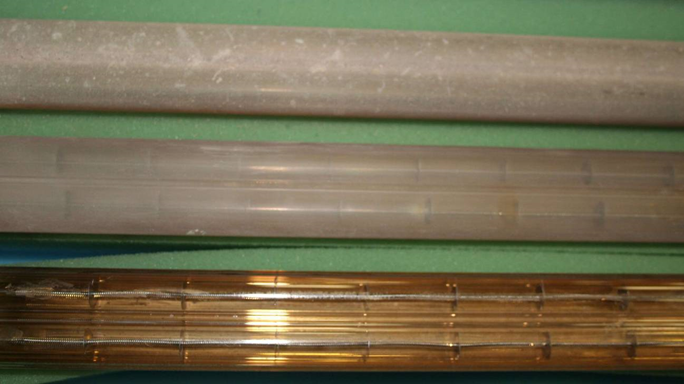The life expectancy of the GED Emitter 100-3746 is estimated at 5000 working hours. In order to optimize the effectiveness of your oven and these emitters it is recommended that you keep these emitters free from debris and glass fragments. The hermetic seal must remain in tact for this emitter to function as designed.
Why should you keep the emitters clean and free from debris?
Any debris, including dust, over time will fuse to the quartz surface of the emitter and will cause the surface to become opaque. Once the emitter starts to become cloudy there is nothing that can be done to make it clear again. Cloudy emitters result in diffraction of IR light causing longer effective wave lengths. In addition, dirty emitters will create more heat buildup on the quartz surface leading to an increased gold evaporation rate resulting in less effective emitters. GED has seen ovens that have lost 40-50% of their ability to heat an IG due to dirty emitters. A sure way to check if your emitters are working effectively is to perform an IG seal check. This can be done through the use of a GED IG Seal Line Verification Kit. This kit will allow you to check the sealant glue-line temperatures to ensure proper sealant adhesion and reduce your seal failures.
What happens if you run with ineffective emitters?
Watching the emitters in your oven turning on and off may lead you to believe that they are performing up to standard. Don’t be misled. The filament life on your emitters is indefinite, so they will light up even if they are dirty or past their effective life expectancy. Lighting up does not mean the emitters are dispersing the proper infrared energy to the sealant. Ineffective emitters may only be heating up the surface of the glass resulting in little to no sealant adhesion, longer cooling periods for the glass leading to longer processing times. To compensate for these ineffective emitters the oven will require a 10% to 50% reduction in conveyor speed to attain the equivalent sealant line temperature. This translates directly into a reduction of throughput by the same amount. There are other contributing factors as well. Debris that collects on the emitters will “bake” on and result in an opaque surface. How soon this will occur is dependent on the End User’s housekeeping procedures and preventative maintenance. This can result in a further reduction in throughput by as much as 40%.
The following picture depicts the various stages your emitters may go through. The bottom photo indicates a new emitter with the filaments clearly visible for the most efficient production. The middle unit begins to display an opaque glass reducing the effectiveness of your emitters dramatically. The top unit is completely obscure and will not be effective at all in sealing your IG units. It is also interesting to note that all of these will light up and give the impression that the oven is working. It is very important to ensure you are checking the health of your emitters on a frequent basis.

Let’s do some math:
Let’s assume a 20% loss in throughput.
A facility can run 2000 lites per shift through an oven.
A loss of 20% results in 400 less units per shift.
There are 260 production days (52 weeks x 5 days), leading to a reduction of 104,000 units.
Assuming a $3 margin on every IG unit, this results in a potential loss of $312,000 per year.
In addition, if your production is reliant on your IG capacity this could result in significant overtime costs, weekend work and ultimately higher costs per IG unit. This could also lead to potential back orders and missed customer commitments resulting in reduced customer satisfaction and potential loss of customers.